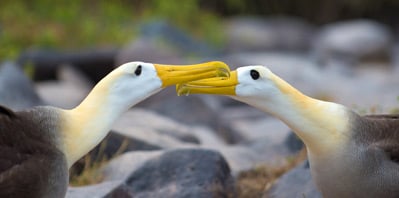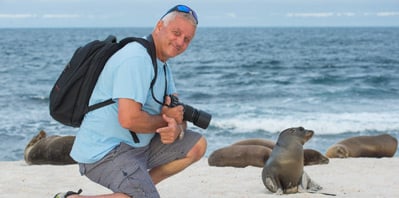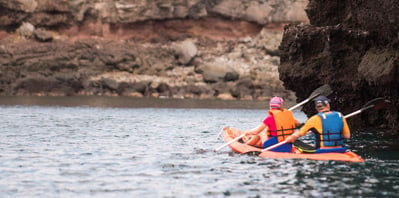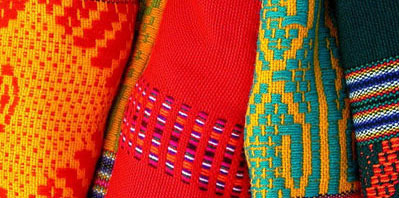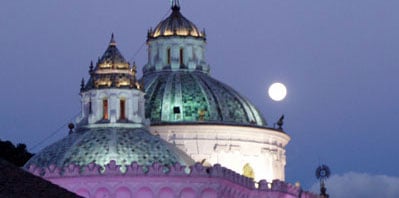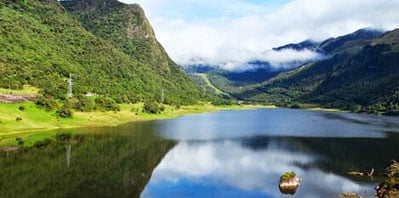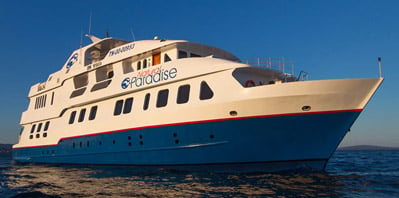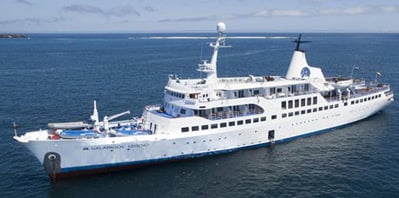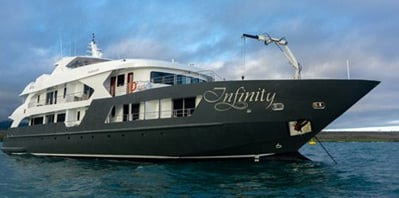Main Islands and Islets of the Galapagos
Every island in the Galapagos has its own particularity, history, animal species, or natural volcanic formations that make them stand from each other. Below you will find a description that highlights the most important feature of every island, as well as links that will lead you to other visitor sites comprehended by the island.
Baltra Island
Baltra, also known as South Seymour, is a small flat island located near the center of the Galapagos. Baltra is home to one of two airports connecting Galapagos with mainland Ecuador and is the point of arrival for most travelers to the Islands. More about Baltra

Darwin Island
Often coined "the best dive site in the world", Darwin Island is an underwater circus with stars like whale sharks, hammerheads, Galapagos sharks, pods of dolphins, and a few killer whales and tiger sharks making guest appearances!
Visitor sites:
- Dawin's Arch
- El Arenal
Española Island
Española Island is located at the extreme southeast of the archipelago. Relatively flat with small hills, a group of geologists found signs of volcanic activity in the 1980s. Vegetation on the island includes many thorny plants and native animals include the waved albatross, marine iguanas, and lava lizards. More about Española
Visitor sites:
- Osborn Islet
- Gardner Bay/Islet
- Suarez Point
Genovesa Island
Genovesa Island is located at the inner part of Darwin Bay. This area contains an abundance of frigatebirds and other interesting seabirds. Behind the small beach filled with nesting areas for frigates, red-footed boobies, and swallow-tailed gulls are a number of tide pools. At high tide it is likely that the trail will be covered with water. More about Genovesa
Visitor sites:
- Darwin Bay
- El Barranco/Prince Phillip's Steps

Mosquera Islet
Located between the islands of Baltra and North Seymour, this reef of rocks and coral (the result of an uprising) is only 160 meters across at its narrowest width. This island has one of the largest populations of sea lions and is home to many shorebirds. There have been occasional reports at this site of Orcas feeding on sea lions.

Rabida Island
Rabida is one of the most colorful and volcanically varied islands in the archipelago and a great snorkeling site. Its famous maroon sandy beach and stunning lookouts provide wonderful landscapes. The island is a birdwatcher's delight. Some of the rarest species are in abundance, such as nine varieties of finches, large-billed flycatchers, Galapagos hawks and brown pelicans.
Santa Cruz Island
Home to the largest town in the Galapagos, Puerto Ayora, the Island has a large variety of vegetation. Pit craters, Scalesia Forest, cacti and ferns are found in its vegetation zones. The island is comprised of a younger part formed by volcanic cones and lava and an older narrow strip of land formed by uplifted lava flows and tuffs. More about Santa Cruz
Visitor sites:
- Puerto Ayora
- Bachas Beach
- Black Turtle Cove
- Carrion Point
- Cerro Mesa
- Charles Darwin Station / Fausto Llerena Breeding Center
- Dragon Hill
- Eden Islet
- Garrapatero Beach
- Highlands
- Lava Tunnels
- Tortuga Bay
- Twin Craters
- Whale Bay
- Gordons Rock
Isabela Island
The archipelago's largest island, Isabela, was formed by the joining of five young volcanoes. While these volcanic regions contain extensive lava fields and little vegetation, the southern highlands and various other regions are covered by dense vegetation including the unique red mangrove. Isabela Island is also home to many native Galapageños living in the island's largest town, Puerto Villamil. More about Isabela
Visitor sites:
- Albemarle Point
- Arnaldo Tupiza Tortoise Breeding Center
- Chico Volcano
- Concha de Perla
- Elizabeth Bay
- Flamingos Lake
- Puerto Villamil
- Moreno Point
- Sierra Negra Volcano
- Tagus Cove
- The Wall of Tears
- The Wetlands
- Urbina Bay
- Vicente Roca Point
- Las Tintoreras
- Cape Marshall
- Roca Redonda
- Tortuga Islet
- Cuatro Hermanos Islets
- Cowley Islet
Santiago Island
Santiago Island has a narrow, steep-sided point of land, which provides an extraordinarily beautiful landscape complete with cliffs and pinnacles where hundreds of marine birds rest. During the 17th and 18th centuries, pirates used this site for maintaining their ships, and supplying themselves with fresh water, meat, and firewood. More about Santiago
Visitor sites:
- Buccaneer Cove
- Chinese Hat
- Egas Port
- Espumilla Beach
- James Bay
- Sullivan Bay
- Albany Islet
- Cousins Rocks

Wolf Island
Wolf Island is located in the extreme northern part of the archipelago. There are no land visits to this island, and it is only visited by live-aboard dive ships. This is a dive site only for experienced divers. The surge is heavy, currents can be quite strong, and visibility is often limited. Some very impressive and large animals such as whale sharks, hammerheads and dolphins are spotted here.
Visitor sites:
- El Derrumbe
- La Ventana
- La Banana
- Shark Point

Pinzon Island
Pinzón is a small island is found to the west of Santa Cruz. It is a great location to see red-lipped bat fish, seahorses, and horn sharks. Dumb Islet is one of the nearby dive sites.

Pinta Island
Pinta Island was the original home of Lonesome George. Introduced goats decimated the vegetation on the island and wiped out the native tortoises. The goats were eradicated in 1990, and the vegetation is beginning to recover. There are no land visits to this island. Cape Chalmers, Cape Ibbetsoin and Nerus Point are one of the nearby dive sites.
Bartholomew Island
Most famous for its view from land, Bartholomew also has a lot to offer below the sea: fascinating lava and rock formations, white- tip sharks, rays, palegic fish, reef fish, rays and turtles. More about Bartholomew

Daphne Minor Island
Located between Santa Cruz and Santiago Islands. Most tourists are restricted from visiting these islands by the Galapagos National Park; however, the islands continue to be a popular stop for scientists researching the unique qualities of the Galapagos finches. Once used as target practice during WW2, the remaining rock piles offer white-tipped sharks and Galapagos sharks.
Fernandina Island
Fernandina, the youngest of the Galapagos Islands, is always a visitor favorite, as it is very beautiful and is home so several species rarely found anywhere else. Punta Espinosa is one of the best visitor sites in the islands, featuring marine iguanas, lava lizards, Galapagos Penguins, flightless cormorants, sea lions and interesting marine life. It is also a great chance to get an up-close look at mangrove plants and different lava formations. More about Fernandina
Visitor sites:
- Espinosa Point
- Mangle Point
- Cape Douglas
Floreana Island
Floreana, officially "Santa María," is located at the far south of the archipelago. The island is associated with a strange and curious history of its inhabitants. Snorkeling around this area is one of the best in the Galapagos. More about Floreana
Visitor sites:
- Baroness Viewing Point
- Post Office Bay
- Champion Islet
- Cormorant Point
- Devil's Crown
- Asilo de la Paz
North Seymour Island
Galapagos Sea Lions, Blue-footed Boobies and Magnificent Frigatebirds are abundant on North Seymour Island. The island was formed by a series of submarine lavas containing layers of sediment that were uplifted by tectonic activity. The island is characterized by its arid vegetation zone. More about North Seymour

Marchena Island
There are no land visits to Marchena Island. It had recent volcanic activity in 1992. The island exhibits pristine flora and fauna since it was never inhabited by humans. The island is remembered for the mysterious discovery of the mummified remains of two bodies on the beach. One of the bodies was the remains Rudolf Lorenz, one of the lovers of the infamous Baroness who lived on Floreana.

South Plaza Island
This small island with steep cliffs was formed by rising lava and is now covered by Opuntia cacti. It is also home to one of the largest sea lion colonies as well as colorful yellow and red land iguanas. The most characteristic plant is the Sesuvium. During the rainy season its color is a greenish to yellowish tone and in the dry season (end of June through January) a bright red.

Santa Fe Island
Santa Fe (Barrington) is home to the small picturesque bay and anchorage on the island's northeast coast. The bay has two visitor trails, one leading to a scenic viewpoint atop a cliff, and the other spanning from a small beach to a tall prickly pear cactus forest.
San Cristobal Island
San Cristobal is home to a small town, Puerto Baquerizo Moreno, and the Junco Lagoon, located 700 meters above sea level. El Junco has been the object of a study in which the sediments on the bottom of the lake were analyzed to uncover information about the vegetation and climate of the archipelago thousands of years ago. More about San Cristobal
Visitor sites:
- Puerto Baquerizo Moreno
- El Junco Lagoon
- La Galapaguera/Jacinto Gordillo Breeding Center
- Interpretation Center
- Kicker Rock
- Lobos Island
- Ochoa Beach
- Pitt Point
- Puerto Chino Beach
- Punta Carola Beach
- Tijeretas Hill
- Witch Hill











